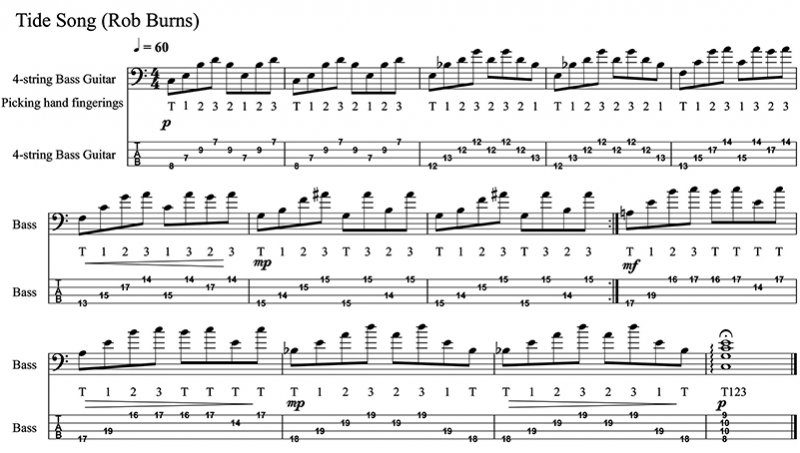Deep Thinking: Fretting Over Picking Technique
Deep Thinking: Fretting Over Picking Technique
What more could a bassist ask for than something to play while sitting in the sun waiting for the onslaught of New Year’s Eve gigs? I may have the answer in a chordal tune that moves slightly away from standard bass playing and utilises the picking hand thumb and first three picking fingers.
This tune is all in two bar sections except for the final bar. Rhythmically, it’s all eighth notes or quavers so it’s quite easy in that respect – take it as slowly as you like although the tempo is already a very slow 60bpm. I have given all the notes for each chord but they are all in different orders in the tune to provide a melodic shape.
The first two bars are built from a Cmaj9 chord (CEGBD – Cmaj7 with a 9th on top but we have left out the fifth, G) played between frets 7 and 9 on all four strings.
If you follow the picking hand fingering numbers, you will see that the thumb leads with a C on string four followed by fingers 1, 2, and 3. This is the fingering for the first half of every bar in the piece.
The picking for the remainder of each of the two bars is 2, 1, 2, 3.
Bars 3 and 4 use an Emin7b5 (EGBbD) chord played up the higher end of the neck around frets 12 and 13. Again, it’s thumb, 1, 2, and 3 but then followed by 2,3, 2, 1. Bars 5 and 6 have an Fadd9 (FACG –an F major triad with a G on top).
The fingering is thumb, 1, 2, 3, then 1,3,2,3.
The next two bars, 7 and 8, have the ‘Hendrix’ chord, and it’s further up the neck at the ‘dusty’ end. This is a G7#9 (GBFA# (again, we are leaving out the fifth of the chord, D)) played on frets 14 and 15. We start the bar with the now familiar thumb, 1,2,3, but we then use the thumb again for the second half of each bar followed by 3,2,3. At this point, there is a repeat sign and you play the eight bars again.
The final section, bars 9 and 10, has an Amin9 chord (ACEB – an A minor triad with a B on top, but not in that order and we are leaving out the b7, G) played between frets 12 and 17. This is a bit of a stretch for the fretting hand with finger 1 on the A at fret 12, finger 3 on the E at fret 14 before it moves to B at fret 16 and finger 4 frets high C at fret 17 on string 1.
Picking is thumb, 1,2,3, followed by all notes picked by the thumb.
You now have to move up to the very top of most necks to pick a Bbmaj7#4 (BbDAE – the perfect fifth, F, is omitted) played at frets 18 and 19 for bars 11 and 12.
Normally, you would keep a #4 away from a root note but I like the dissonance!
Picking is thumb, 1, 2, 3 followed by 2, 3, 1, thumb.
The final bar is a standard C major chord played between frets 8 and 10 – C, G, C, E, picked by the thumb and fingers 1, 2 and 3. The chord is a ‘broken’ chord – the notes are played almost as a chord but at a slower tempo than the quaver figures that have preceded it.
This may be a new concept in your picking technique in that you are essentially using a guitar-style picking method, but you can play it with a pick if you wish to. See you next time and have a great summer. But keep practising!
Dr Rob Burns is an Associate Professor of Music at the University of Otago in Dunedin. As a former professional studio bassist in the UK, he performed and recorded with David Gilmour, Pete Townsend, Jerry Donahue, Isaac Hayes, Sam and Dave, James Burton, Ian Paice and Jon Lord, Eric Burdon and members of Abba. He played on the soundtracks on many UK television shows, such as Red Dwarf, Mr Bean, Blackadder, Not the Nine O’Clock News and Alas Smith and Jones. Rob is currently a member of Dunedin bands Subject2change and The Verlaines.

